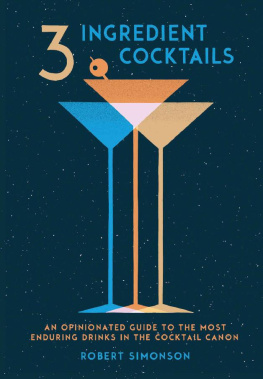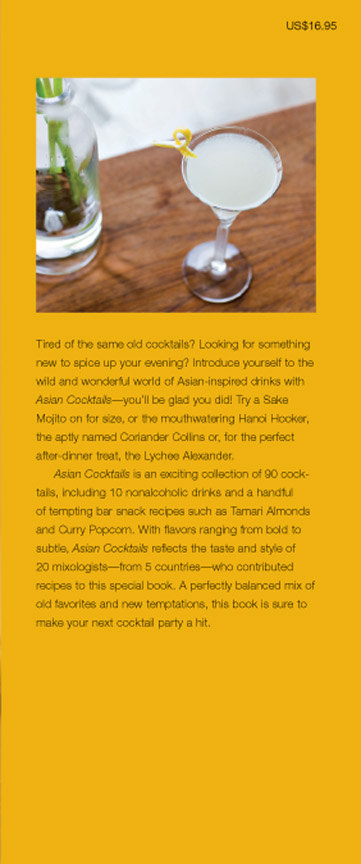acknowledgments
Christine and I would like to thank all of the mixologists and chefs from around the world who contributed cocktails and bar snacks to this book. Id also like to thank Yukari Sakamoto for answering my questions about shochu (http://tokyostation-yukari.blogspot.com/). I am indebted to Gary Regan for teaching me the basics of making a good drink, to my friend Todd for accompanying me on our cocktail workshops at Milk and Honey in NYC, and to Mike for putting up with sticky counters during endless testing rounds. Gorta would like to thank the following people and businesses for helping to facilitate the photography for the book:
Ms. Kikuko Fujimoto and Ms. Yoko Fujimoto (for making the cocktails)
Chinatsu Kambayashi (for styling)
Zwiesel Boutique (for supplying glassware)
FLEG Daikanyama 1F
1-31-12 Ebisu-Nishi Shibuya-Ku
Tokyo 150-0021 Japan
Tel: +81-3-3770-3553
www.zwiesel-kristallglas.jp
Gallup East Showroom (for supplying backgrounds and props)
1F 2-4-4 Tomioka Kouto-Ku
Tokyo 135-0047 Japan
Tel: +81-3-5639-9633
www.thegallup.com
House Restaurant (for providing on-site settings)
Show Case 4F
2-24-7 Nishiazabu Minato-Ku
Tokyo 106-0031 Japan
Tel: +81-3-6418-1595
bills SHICHIRIGAHAMA caf/restaurant (for providing on-site settings)
WEEKEND HOUSE ALLEY 2F
Shichirigahama Kamakura-Shi
Kanagawa-Ken 248-0026 Japan
www.bills-jp.net


Raising the bar
If you walked into a bar and asked for an Asian cocktail youd probably get a blank stare from the bartender. Its about as vague a request as asking for an American cocktail. But if you mention a classic by namelike the Singapore Slingor mention that youd like a cocktail that uses Asian ingredients, such as ginger or lychees, youre likely to get a nod of recognition.
Asian cocktails are both old and new: they are classic, the familiar exotic and the newest taste sensation. In this collection of recipes youll find cocktails such as the Japanese Cocktail, Bamboo Cocktail and Singapore Sling that date to the Golden Age of Cocktails (1860s to 1900) and to the Roaring Twenties. Some tropical rum-based classics, such as the Mai Tai and Scorpion, concocted sometime around the mid-twentieth century, are also included. (Since theyve also made their way onto menus of Japanese steak houses and Chinese-American restaurants, how could we not include these Tiki Bar favorites?) These delicious oldies have names that evoke Asia and some were even created in Asia, but most dont have a single Asian ingredient in them.

Its taken a new generation of mixologists, many working behind bars in Asian restaurants or restaurants that feature Asian ingredients, to create cocktails that are more genuinely Asian than the exotic sounding drinks of yesteryear. The increased interest in Asian cuisines in the West has spilled over from the kitchen to the bar, where cocktails are often created to pair with the food being served. As a result some of the most interesting Asian cocktails are now being created in restaurant bars where the relationship between the bartender (bar chef) and kitchen chef is symbiotic, and where the bartender has ready access to lots of fresh and dried Asian ingredientsfrom spices to fruits and herbs. The majority of the cocktails in Asian Cocktails, some created especially for this book, are examples of the new Asian cocktail.
Whether putting an Asian spin on a classic cocktail, such as the Jujube Manhattan, or creating a new drink al together, there are a variety of ways that mixologists make a cocktail Asian. Some use Asian wines or liquors, such as sake, plum wine, shochu or Japanese whiskey while others infuse a Western liquor, usually vodka, with an Asian ingredient and use that as the basis for a unique cocktail. Others may use Asian mixers or other flavoring components, such as mango juice, Calpico, lychees, fresh Thai basil, fresh lemongrass, chiles or fresh ginger with Western or Asian wines or liquors.
As when making any cocktail, using good quality liquor and fresh ingredients is key. The balance of sweet and sour in relation to the liquor is the typical driver of flavor, though other flavors, like bitter (via bitters) and spicy or piquant flavors, can add magic to the balance. Bitters are the umami of the barused in the same way a cook may use a small amount of fish sauce or anchovies to add nuance thats hard to pinpoint but noticeably lacking when absent. Just a couple of drops of these potent flavoring agents are used to give depth and interest to cocktails. Bitters also add a counterpoint to liqueurs, fruits, syrups or other sweet ingredients, sometimes working along with sour citrus to do this. As the interest in well-crafted and vintage cocktails rises, old brands/recipes of bitters are being resurrected and new ones are being created. Or ange bitters, which is used periodically in this book, is in fused with orange peel and spices. Aromatic bitters, such as Angostura, tend to be bolder and more complex, with greater amounts of cinnamon, clove and anise.
Whereas bitters have long been used in the West in cocktails, spice is a relatively new phenomenon intro duced via Asian cocktails, where spicy ginger or chiles add a noticeable kick to drinksadjusted, of course, to personal taste. And while salt, the last of the five basic taste sensations, is not normally included in cocktails, ex cept to rim a margarita, it is used to heighten flavor in the distinctive Silk Road, Nashi Cocktail and Little Tokyo Coolermuch in the way a pinch of salt is used in baking.
HOW TO USE THIS BOOK
If Asian cocktails havent found their way into your neigh borhood bar/restaurant bar, you can easily make them at home using the recipes in this bookonce you stock your bar and pantry with some basic equipment and in gredients. The sections at the beginning of the book Glassware, Stocking the Bar, and Tools and Techniqueswill help you set up a basic bar and teach you the techniques youll need to craft a cocktail. The recipes in Syrups and Infused Spirits are the jumping-off point for many great cocktails. When making cocktails using infused spirits remember to plan ahead as most in fusions take an average of two or three days, and some longer, to make. Syrups can be prepared very quickly they only need sufficient time to cool before using.
While the focus of this book is on the use of fresh in gredients, there are a variety of new flavored vodkas and liqueurs on the market with Asian flavors: Pama (pome granate), Zen (green tea), SoHo (lychee), Hangar One vodka (kaffir lime), to name a few. Weve included a hand ful of drinks that use some of these high-quality products as they need only be shaken or stirred with one or two other ingredients to create a cocktail. This is worth con sidering when you are entertaining and need to make several drinks quickly.
















